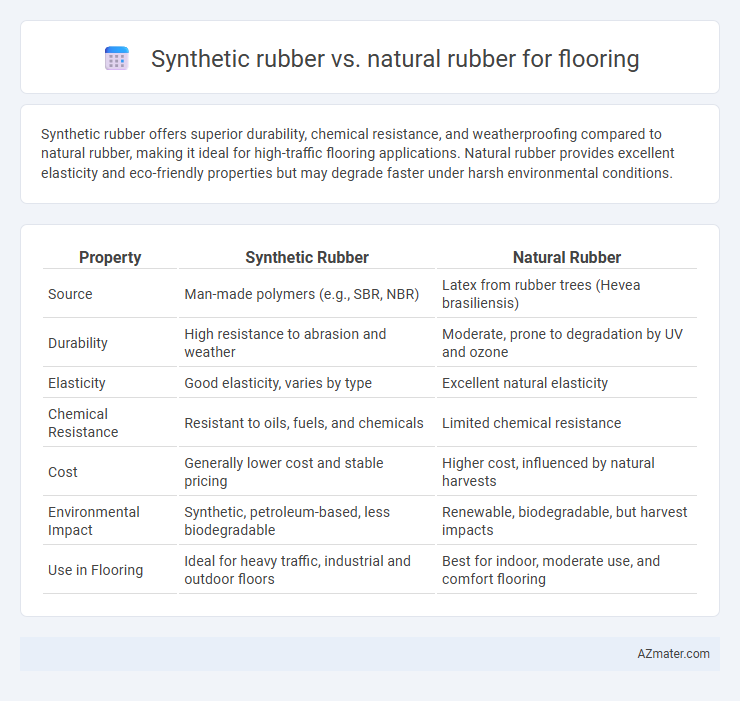Synthetic rubber offers superior durability, chemical resistance, and weatherproofing compared to natural rubber, making it ideal for high-traffic flooring applications. Natural rubber provides excellent elasticity and eco-friendly properties but may degrade faster under harsh environmental conditions.
Table of Comparison
| Property | Synthetic Rubber | Natural Rubber |
|---|---|---|
| Source | Man-made polymers (e.g., SBR, NBR) | Latex from rubber trees (Hevea brasiliensis) |
| Durability | High resistance to abrasion and weather | Moderate, prone to degradation by UV and ozone |
| Elasticity | Good elasticity, varies by type | Excellent natural elasticity |
| Chemical Resistance | Resistant to oils, fuels, and chemicals | Limited chemical resistance |
| Cost | Generally lower cost and stable pricing | Higher cost, influenced by natural harvests |
| Environmental Impact | Synthetic, petroleum-based, less biodegradable | Renewable, biodegradable, but harvest impacts |
| Use in Flooring | Ideal for heavy traffic, industrial and outdoor floors | Best for indoor, moderate use, and comfort flooring |
Introduction to Synthetic and Natural Rubber Flooring
Synthetic rubber flooring, made from polymers such as styrene-butadiene rubber (SBR) and ethylene propylene diene monomer (EPDM), offers enhanced durability, chemical resistance, and consistency in quality compared to natural rubber flooring derived from latex harvested from Hevea brasiliensis trees. Natural rubber flooring provides excellent elasticity, thermal insulation, and biodegradability, making it a sustainable choice, though it may be prone to degradation under UV exposure and harsh chemicals. Selection between synthetic and natural rubber flooring depends on specific application requirements including wear resistance, environmental impact, and maintenance considerations.
Composition and Production Processes
Synthetic rubber for flooring consists primarily of polymers such as styrene-butadiene rubber (SBR), nitrile rubber (NBR), or ethylene propylene diene monomer (EPDM), produced through controlled chemical polymerization of petroleum-derived monomers. Natural rubber is composed of polyisoprene extracted from the latex of rubber trees (Hevea brasiliensis) via tapping and coagulation processes. Production of synthetic rubber involves complex industrial processes like emulsion or solution polymerization that offer consistency and tailored properties, whereas natural rubber relies on agricultural harvesting and minimal chemical modification, influencing durability and elasticity in flooring applications.
Durability and Longevity Comparison
Synthetic rubber flooring offers enhanced durability and superior resistance to wear, chemicals, and moisture compared to natural rubber, making it ideal for high-traffic areas. Natural rubber provides excellent elasticity and comfort but tends to degrade faster under prolonged exposure to UV light and harsh environmental conditions. The longevity of synthetic rubber often exceeds that of natural rubber by several years, making synthetic options more cost-effective for long-term flooring solutions.
Environmental Impact and Sustainability
Synthetic rubber flooring, derived from petroleum-based polymers, often involves energy-intensive production and limited biodegradability, contributing to environmental concerns and landfill accumulation. Natural rubber flooring, sourced from Hevea brasiliensis trees, offers a renewable, biodegradable alternative with a lower carbon footprint and supports sustainable agroforestry practices. Choosing natural rubber enhances eco-friendly flooring options by promoting resource renewability and reducing long-term environmental impact.
Cost Differences: Synthetic vs Natural Rubber
Synthetic rubber flooring typically costs less per square foot than natural rubber due to lower raw material and production expenses. Natural rubber flooring offers superior durability and eco-friendliness but comes with a higher price tag reflecting its sustainable sourcing and longevity. Cost differences influence project budgets, with synthetic rubber favored for budget-conscious installations and natural rubber chosen for premium, long-lasting flooring solutions.
Design Options and Customization
Synthetic rubber offers a broader range of design options and customization due to its ability to be produced in various colors, textures, and finishes, accommodating specific aesthetic preferences and functional requirements. Natural rubber flooring provides a classic, natural look with limited color choices, primarily in earth tones, making it ideal for eco-conscious spaces but less versatile for creative designs. Advances in synthetic rubber technology enable intricate patterns, logos, and enhanced durability, supporting diverse commercial and residential applications where personalized flooring solutions are essential.
Health and Safety Considerations
Synthetic rubber flooring offers enhanced chemical resistance and lower allergenic potential compared to natural rubber, reducing health risks in indoor environments. Natural rubber contains proteins that may trigger allergic reactions in sensitive individuals, while synthetic alternatives are hypoallergenic and emit fewer volatile organic compounds (VOCs). Fire resistance and slip resistance are generally superior in synthetic rubber flooring, contributing to safer surfaces in high-traffic areas.
Maintenance and Cleaning Requirements
Synthetic rubber flooring requires less maintenance due to its higher resistance to stains, water, and chemicals, making it easier to clean with standard detergents and water. Natural rubber demands more careful cleaning methods to prevent damage from harsh chemicals and moisture, often needing specialized cleaners and regular conditioning to maintain its durability and appearance. Choosing synthetic rubber for flooring ensures lower long-term maintenance costs and simpler cleaning routines especially in high-traffic or commercial environments.
Performance in High-Traffic Areas
Synthetic rubber flooring outperforms natural rubber in high-traffic areas due to its enhanced durability, abrasion resistance, and consistent quality. It maintains elasticity and cushioning under heavy use, reducing wear and tear while providing superior slip resistance. Natural rubber offers biodegradability and comfort but is more susceptible to degradation from moisture, UV exposure, and chemicals typically encountered in high-traffic commercial environments.
Best Applications for Each Rubber Type
Synthetic rubber, such as EPDM and SBR, excels in commercial and industrial flooring applications due to its superior abrasion resistance, weather durability, and chemical resistance. Natural rubber is ideal for sports and gym flooring, offering excellent elasticity, resilience, and shock absorption, which enhance athlete comfort and injury prevention. Choosing the best rubber type depends on environmental exposure, load requirements, and specific performance needs of the flooring project.

Infographic: Synthetic rubber vs Natural rubber for Flooring
 azmater.com
azmater.com